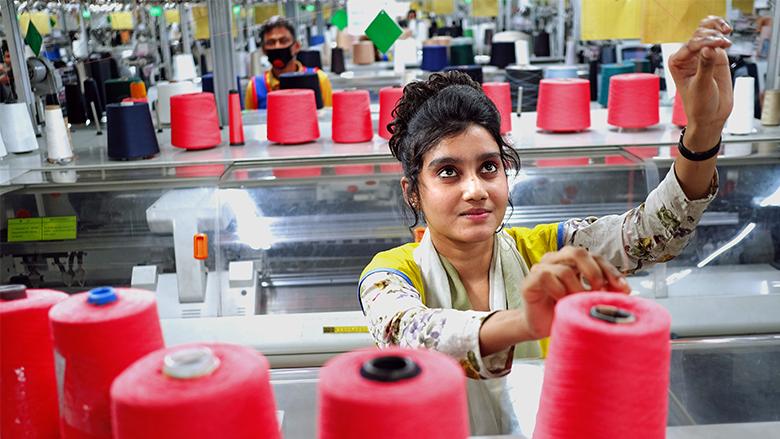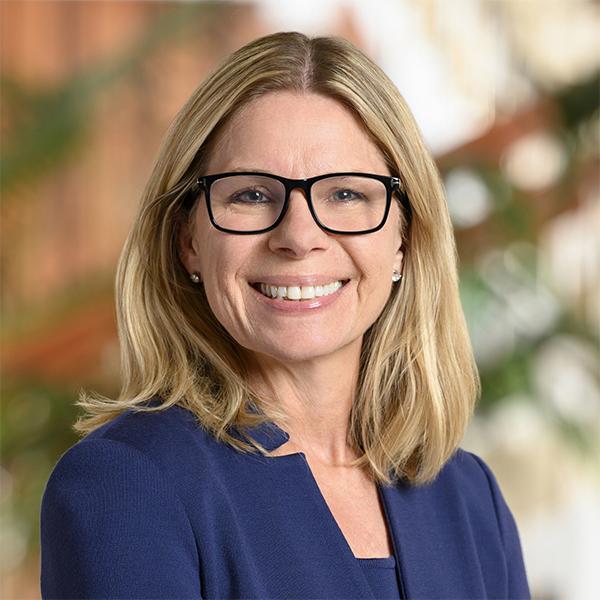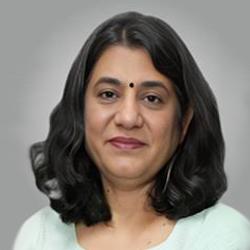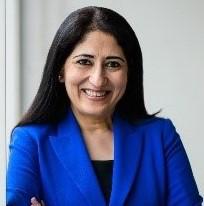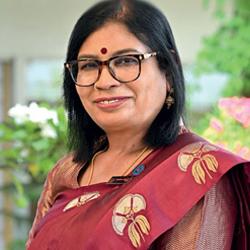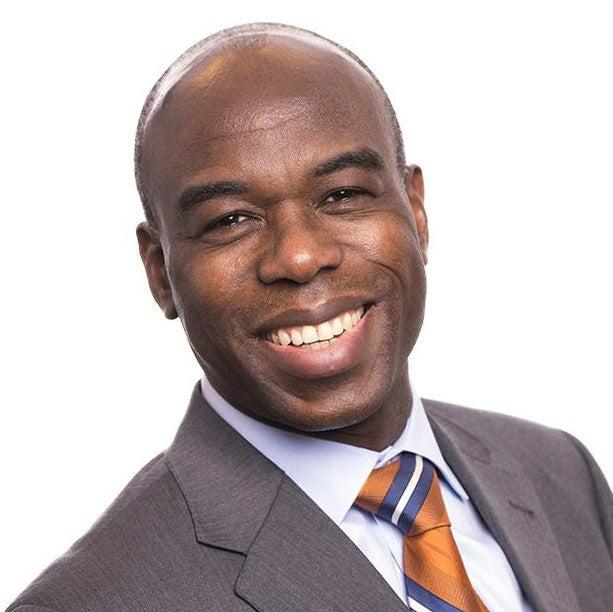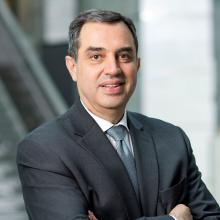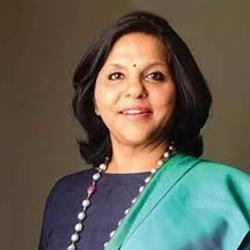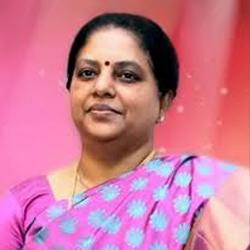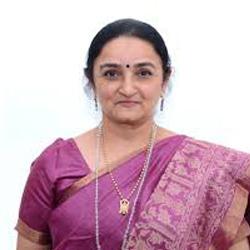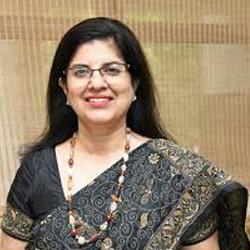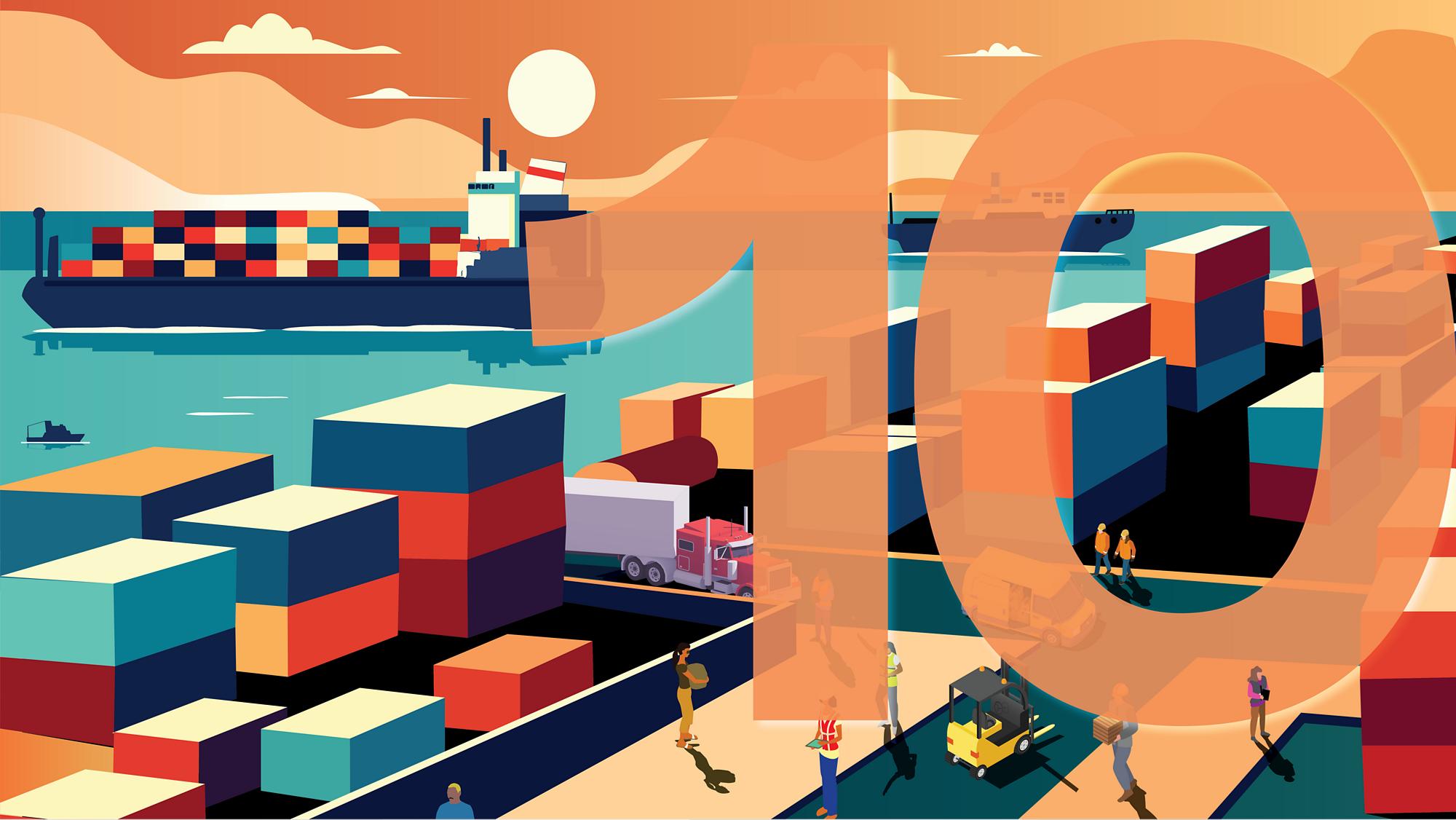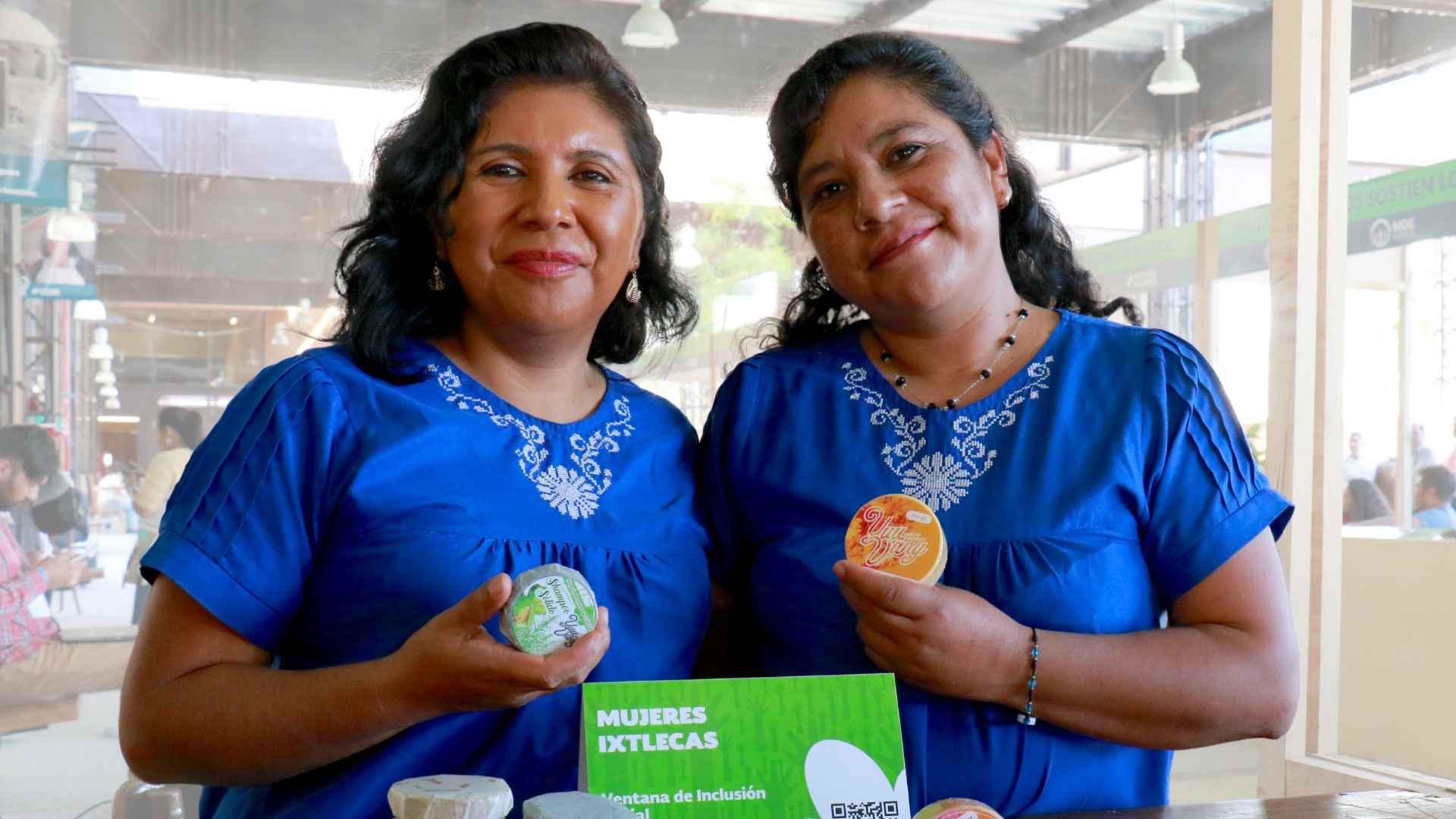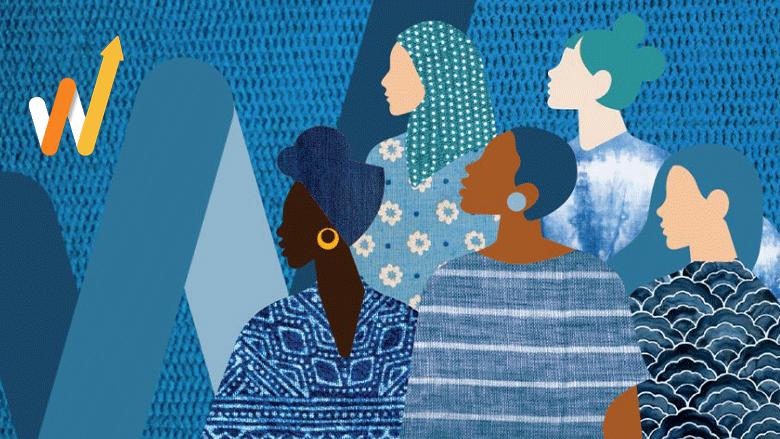[Parikshit Luthra] Thank you, everyone, for joining us. We’re going to begin in a minute. I wonder if we can shut the doors or we’d like to keep them open for more people to come in. All right. Thank you so much. A very, very Happy Women’s Day to everyone here. In fact, I would rather say Happy Women’s Financial Inclusion Day because that’s what we’re discussing today. Through the course of this one week, I have interacted with many women who feel that the conversation on women empowerment now needs to change. It needs to be about greater financial inclusion. It needs to be about greater mentorship of women to make sure they reach leadership positions, not just in their companies, but also at a board level as well. Now, today, we’re going to be discussing capitalizing on women breakthroughs and financial inclusion. Ladies and gentlemen, we can’t be discussing this at a more important time in history. The world is going through a clear reset. We’re looking at two wars which have been raging on for years now. We’re looking at massive trade wars and also weaponization of supply chains, a country’s natural resources as well. In fact, many estimates suggest that over the next two years, the growth everywhere is going to be slow. Countries are going to be looking inwards. We’re also going to see a different demand, also a different investment, because why would companies want to invest? There is global uncertainty, so what do you want to invest in? There will be all those problems, and probably this is where we need more women leaders. We need women to be a part of the workforce, to have greater access to capital, and provide leadership as well. In fact, in the last 10 years, we’ve been seeing many schemes for women which have been launched by the National Government, by Prime Minister Modi. You’ve had the Mudra loan scheme, you’ve got the “Beti Bachao, Beti Padhao”, the “Lakhpati Didis” scheme, the “Drone Didis” scheme. In fact, this year, we saw a 37% increase in the gender budget in the Union budget to 4.49 lakh crore rupees. The budget also laid out a roadmap to make sure that 70% of women in the country are part of the workforce. In fact, I must mention a recent World Bank report which said that if India has to become a high-income country by 2047, they must have a 7.8% growth rate in a sustained manner year on year. At the same time, the women participation in the workforce must be high as well. It must be around 50% towards very ambitious goals. Clearly, we don’t have an option. I’m sure all our panelists and everyone in the audience believes that having more women in boardrooms, a part of our policy-making in business and in government, is only right for business. Without saying much more, let me introduce all our panelists. We’ve got Shivani Bhasin, founder and CEO of India Alternatives. We’ve got Jyoti Vij, Director General, FICCI, Federation of Indian Chambers of Commerce and Industry. A. Manimekhalai, CMD of the Union Bank of India. Nupur Garg, founder, WinPE Forum. Ladies and gentlemen, a big round of applause to all our panelists. Just before we start, I’d like to call upon the Country Director of the World Bank for India, Auguste Tano Kouamé, for some opening remarks.
[Auguste Tano Kouamé] Thank you very much, Parikshit. It’s really an honor to be here. I feel almost intimidated to see so many powerful women in the room, but let me start by wishing you all happy International Women’s Day and happy 50th anniversary of the International Women’s Day. In the earlier panel, we saw so many powerful women, including, and especially the President of India, the Honorable President of India, such a symbol of what can happen when women are in leadership role. I would like to congratulate the Honorable President of India and the presidency of India on this day and making it so big and thank them for associating the World Bank to this event. I’d also like to thank the Ministry of Women and Child Development for their leadership in organizing this event and for associating us. With special thanks to the minister, and the Secretary of the Ministry. I was really fascinated by the story of the Minister of Law and Justice, and how men can play a role in advancing the gender agenda. We don’t take it lightly at the World Bank. At the World Bank, for us, gender is everybody’s business. Here in India, I take personal responsibility to make sure that this is drilled down in everything we do, and not just in our project, but also in what we do on a day-to-day basis in our office, in our homes. As Parikshit said, a recent report, the Country Economic Memorandum, says clearly that India can achieve “Viksit Bharat” by 2047, but this requires a 7.8% growth rate on average between now and then. This growth rate is almost 1.5% point higher than what India has sustained in the past generation, in the past 25 years. What does it mean? It means growth needs to increase. Some other research we’ve done before show that if female labor force participation were to increase from where it is today to 50% to 55%, this will add 1% point to GDP growth. This means this will take India closer to the “Viksit Bharat” during the Amrit Kaal, this is achievable. We also show in the Country Economic Memorandum that investment needs to increase from what it is today to about 40% by 2035, and then perhaps stabilize. For investment to increase to that level, it needs to be driven by private sector investment. For private sector investment to grow that fast, women need to be participating in investment. For that to happen, guess what? Financial inclusion becomes really central. Not just having access to banking account, but having access to capital, as our Managing Director said in the earlier panel, Anna Bjerde, whom I would like to recognize here. Thank you, Anna, for your leadership on this agenda in the World Bank Group. Investment needs to increase? Yes. The third thing that needs to increase for 7.8% to happen, according to our Country Economic Memorandum, is productivity needs to increase from about 2% to about 3% during the Amrit Kaal. For productivity to increase, guess what? Again, it’s a gender agenda. Because women make better decisions, generally, than me, for sure. [Laughs] Research shows that when women are in the boardroom, when they’re in leadership positions, when they’re in management, decisions are better. When decisions are better, productivity is better, the economy functions better, more smoothly, more productively, and the economy is more resilient because they make decisions that are better for the resilience agenda as well. Whether it is to increase female labor force participation and the role of human capital in growth, or the role of capital in growth, or the role of productivity in growth, gender agenda needs to move forward and that requires financial inclusion. We heard earlier, gender is a leader in that. India has 80% of women who have access to a bank account. This is much higher on the global average. Women participate a lot in various programs that the government of India has introduced. The PMJDY, has about 55% of participants who are women. 69% of Mudra loans are to women. This is fantastic. 90% of unique microcredit borrowers are women. This is great, but there is more to do. Only 28% of bank borrowers are women. We need to ask why not? There is a gap in digital utilization for financial purposes of 13%. So, men utilize digital means for financial transactions more than women. And 42% of women’s bank account are inactive. We need to ask why, what is happening? Some of our research gave some ideas already, and I would love to hear from the panel, their perspective on this. One finding is that when banking correspondence are women, women participate more in banking, and they use their banking account more actively. Only 10% of banking correspondence in India are from women. I was in a meeting in Bihar, we have this great project, JEEViKA, and so many of you have heard about. It has made a lot of progress in including women in everything, from farming to banking. We met some banking correspondence, and they were all men. I said this cannot be right. Men are good at banking correspondence, but women need to be present more in the boardroom and as the bank tellers. There is a good example. IFC has a client, I think it’s the Federal Bank, I hope I’m not making free publicity here, that has 43% women in their workforce and many women in their leadership. They really, really focus on that. If you are a banker in the room, please include more women in your workforce and have more women as banking correspondents because that will increase the use of women’s bank account. Globally, only 16% of venture capital and private equity fund managers, only 16% of them are women. Only 16% are women. This is not good because it means when women go to them for a loan and for their projects, they probably have a very limited understanding of what this project is about because they can’t really relate to it. They can’t relate to a proposal where women will say, “I want to work only six hours a day because I need to spend another two hours at home doing important things for society.” They’ll say, “Well, I’ll give the loan to the person who says I can spend 16 hours a day working.” Well, that would be a mark. More of the decision-makers for loan and credit have to be women. I know I’m taking very long. I’m very passionate about it, but I’ll close very soon. I’ll say, at the World Bank, we are aware that women also need to increase their financial literacy. We’ve done quite a bit of that working with CEWA and other Self Health Groups. If you are one of those and you are interested in this, please talk to us. We would like to work with you to increase financial literacy for women because that also helps to increase their participation. I want to close by saying for us, just as I like joking that on February 14, we celebrate love and relationships, we should do it every day. International Women’s Day should be every day. Just as Mother’s Day, every day, we celebrate our mothers every day, we should celebrate our women every day. Let’s not wait for the next 50 years or the next March 8 to move forward with this agenda. It should be every day’s business. It should be everybody’s business, and you can count on the World Bank to work with you as a partner. Thank you very much, and I’m looking forward to it.
[Parikshit Luthra] Thank you so much, Auguste. We couldn’t agree with you more. One thing that came to my mind while Auguste was speaking, was that many of the Indian government schemes make sure that when the funds are transferred to a particular family or a particular target group, the funds are transferred to the woman of the family. There is a clear feeling and understanding and belief that women handle funds better. Why shouldn’t we have more financial inclusion? In fact, I do think our Prime Minister said some time back, and this was many years ago, that when it comes to women, they always save for a rainy day. When there is a problem in the house, you know you can count on the woman in the family to lead and support the family in that hour of crisis because she has been saving for that time of crisis. With that, let’s open this up with our wonderful panelists here, all of them big achievers in their field. Lots to hear. It’s going to be a master class, lots to take away. I hope whatever we speak about here brings about some real change in the days to come. So, Shivani, I’m going to kick this off with you. What’s the sense of some of the challenges that women in own startups, businesses, have been facing, the problems they’ve been facing in accessing capital, and how things have changed over the years?
[Shivani Bhasin] Thanks so much, and very excited to be here today. Happy International Women’s Day to all. I’ll jump right in, Parikshit. Before I answer that question, I’m actually going to lay a little bit of a narrative or a story for you as to how strange it is that we have these unique challenges. Women make up the largest addressable market for investing in India. According to our internal estimates based on reports from the World Bank, RBI, BCG, etc. Now, women control 70% to 80% of all consumption decisions in India, making them perhaps one of the largest addressable markets at 1.5 trillion dollars. Women in online shopping, the change is even more stark in the post-COVID world. There are many reports. I don’t have a particular research report, but we have found various estimates. Our estimates are there are possibly more than 100 million women shopping online. To your point, sir, on women borrowers, we are investors in a credit bureau in India, and we find that by the end of ‘24, we expect 27 million women actively monitoring their credit score. This is very interesting. It comes to the same point about women wanting to be prepared, women taking the necessary steps, managing their credit score, understanding where credit is coming. Women in the workforce. It was so wonderful to hear. I would like to reiterate this very important point about the labor force participation if we can increase it from 35% to 50%, 55%, that’s a staggering 1% increase in GDP. What I’m really excited about is the young women. If you look at the data by the Ministry of Education, there were 2 million STEM graduates in 2022, of which 44% were women, and 5.7 million graduates in other fields with 53% women. I’m going to bring this a little bit more home to my industry because I’m a private equity investor. So, entrepreneurship, startups, this is what I track. If you look at the Department for Promotion of Industry and Trade, women-led startups have increased by 2,700% to 3,644. Sorry, I wanted to put that out there before I got into the challenges because it is even more strange and more paradoxical that we have these challenges. While it is so encouraging to see these green shoots, what happens is a lot of the women fall out because of lack of access to finance, due to very few women fund managers like myself. Lack of exposure to business opportunities, a lack of confidence, and a feeling of preparedness. I think we’ve all made this, and I’m going to make this generalization, but as women, we love to be prepared. We want to be overprepared for every situation. If we don’t feel prepared, we’re not going to go ahead with it. Despite growing efforts, we talked about diversity, equity, inclusion, women-led startups receive a disproportionate low amount of funding. We found some interesting data, so I’m going to share this. According to DealStreetAsia, in ‘24, women-led startups receive less than 9% of total funding in India. I don’t have a full grasp on the percentage of women fund managers in India. Based on various reports, that number could be as low as 7%, maybe 10%. If I come back to the data that I just talked about, less than 9% of women-led startups are receiving the total funding. It’s no surprise. It’s absolutely no surprise. I think the second part of your question, Parikshit, was what we can do to address some of these challenges? I think, first of all, we have to include gender lens investing in everything we do. Gender lens investing is broader than saying, “We’re going to push women, we’re going to encourage more women to invest.” We absolutely need to do that, but we also need to have a lens for investing in companies that prioritize women products. Guess what? If you have more companies that prioritize women’s products and services, oftentimes, they tend to be led by women. When they are led by women, they often have more gender balance teams. When you have more women fund managers, the money starts flowing naturally. We need to make women a top priority. I’ve spoken a lot, but I’m going to end with one more statistic on this first question. According to IFC’s Gender Smart Investing Report, gender balance funds have realized an excess net IRR of 1.7% points greater than all male or all female dominated funds, when controlling for vintage geography and strategy. So, this makes business sense. I think that’s the point that I really want to elaborate. This makes business sense. We’re in a paradoxical situation in the country, where it’s our time to take it forward. We have young women who are very ambitious. They are coming into STEM. They are starting companies. We have to do it, and the time is now for us to do more, to support them, to evolve to the next stage.
[Parikshit Luthra] Shivani, beautifully put, clear business case for greater women inclusion in the financial sector, giving them better access to capital because the growth rates that we are aiming for is not going to happen without having that gender lens to all our policy making. That’s not just for business, but for government as well, and governments across the world. Let me get in Ms. Jyoti Vij, who has tremendous experience in representing the industry body, Federation of Indian Chambers of Commerce and Industry. Ms. Vij, let me begin by asking you, how do you think organizations like yours and the industry can help women entrepreneurs be better prepared when it comes to accessing or making the pitch to banks and financial institution for capital? Because that was the problem that Shivani and I were talking about a little while back, that women sometimes need to be better prepared, or they also need to have a better knowledge of what they can really access.
[Jyoti Vij] Thank you, Parikshit, and thank you for having me here, and a happy International Women’s Day to everybody. I think we’ve all talked about the need to have more and more women participate because it makes immense economic sense to have them. This is not just an imperative to have women there, but it is an economic imperative to have greater women participation. And we, at FICCI, have been driving the whole women-led development agenda. This is our key priority area that has been identified. You also know that we have the FICCI Ladies Organization for over the last four decades promoting the women entrepreneurship, and we’ve been part of the various multilateral organizations like the Women BRICS Alliance, the G20 EMPOWER, etcetera. I think some of the issues do resonate across, and it’s not just a very India-specific issue. The problem, the intensity might vary from country to country. When we started to look at various policy actions, and I think that’s where we, as a chamber, come in, we work on capacity building, and we also work in the policy actions, policy recommendations to the government. When it comes to capacity building, I think financial literacy or digital literacy, these the two aspects really stand out apart from, of course, education, because these are the two aspects where we feel this bridge really needs... The gap really needs to be bridged. These aspects, if they’re bridged, I think they enable women far more to add to the point which Shivani said that women want to be prepared. I think this is what helps them prepare even better. The second aspect, and I think this came out of our discussions at various international fora, is how we can have the women be mentored. How do we mentor women who are already enabled, people like us who have the opportunity, how do we mentor ten more women to understand what are the business opportunities available there, how do you access financing? How do you access markets? All of those aspects which are significant for you to make your enterprises work successfully. When we come to the policy, a few aspects that we discussed, particularly related to financial inclusion and the access. I was just talking to Ms. Manimekhalai a while back as to how you help, and she did recount several initiatives being taken by them. But I think still the access remains far more skewed when it comes to women. Only 10% of the women managed to get formal credit. We know that the SG model has been immensely successful in the country. Why? Because it’s a women-led cooperative, and the fact that women are better manager of finances is something which has been well proven by that. It’s happened a lot in the rural enterprises. We need to scale that up here. How it happened is because we went in a cooperative form. We diversified the risks. How do we diversify the risks? Another conversation I was having with her is that we’ve been talking about the need for a credit guarantee fund. I think that’s... Maybe the World Bank can really help us in actualizing that because we talked about the credit bureaus, and women being very mindful of all of that, and looking for information, that could help us really set up a credit guarantee fund specifically for women loans. Also, ma’am, I think the gender desegregated data are still missing. I think that’s an important aspect that we highlighted. I mean, that got highlighted to us at the multilateral fora that we participated in. I think these two aspects with a lot of literacy and mentorship, support, etc. I think we can have more and more women enterprises coming. I don’t want to talk about the significance of having women enterprises. I think Shivani has beautifully elaborated on that, but we just need to add more strength to them. I think it can be a win-win for everybody.
[Parikshit Luthra] All right. Thank you so much for those opening remarks, Ms. Vij. Let me get in Ms. Manimekhalai right now. Ma’am, a remarkable journey is what we can describe about your career. You are the CMD of Union Bank of India. Give us a sense of how the role of women in the banking sector has evolved over the last few decades that you’ve seen the banking sector closely and the perception of women entrepreneurs there as well.
[A. Manimekhalai] Thank you, Parikshit, for this wonderful question. As all of us always say, every day is women’s day, actually, to Dr. [unintelligible] who said this. Actually, if you look at the way the banking sector has progressed, we had women at the workforce, labor force, in the banking sector were quite a number. That wasn’t a problem at all. Even today, if I talk about my bank, it’s about almost 30% of the workforce in the bank was women. But if you look at the business leaders, the perception of the women entrepreneurs has shifted actually from being the micro borrowers to significantly contributing to the economic growth of the country. Traditionally, if you look at women, they were struggling to open bank accounts. The access to credit was limited. There was societal bias. There was low financial literacy. There were no tailor-made schemes for the women. Today, if you look at all these things, it’s actually shifted. A lot of money schemes, the government has... If you look at the JAM trinity that came out, the PMJDY and the Aadhaar and the mobile, this really shifted the banking sector and how the women participated in the growth of the country. Now, if you look at the participation also of the women in the credit and banking, there are a little bit of statistics to this. Women-led businesses have increased over almost 40%, but now that URC is very important for the MSME sector. You know that the registered MSMEs are, it’s increased almost 40%. Women-owned MSMEs in India are employing close to 28 million. PM SVANidhi Yojana, that all of us are aware, this also has almost 31 lakh women street vendors. It could be a small thing that the government has done, but it has brought the women into the labor force, got the women to stand on their own feet. Now, 6,000 crores have been lent to women, SVANidhi, of course. We also have about 20% of the startups in India, the founders of women. Now, if you look at the other part of it, now there has been a sectoral shift also. Agriculture employed almost 63% women in the agriculture. Now, that has changed, that has gone. The sectoral shift, agriculture, 63% women has come down to almost 40%. This has shifted to, you can say, technical-driven industries in the other MSME sector. That’s how it has improved. Also, we have seen risk perception of the women. There are many women who are getting into civil, looking at their scores. That has also shifted the way women look at business. That’s one thing. A lot of things that the government has done, if you look at the [audio cuts off] schemes that the government has come out with, Startup India that’s come out. Now, even a new union budget has also come out with something for women, up to 2 crores for startups for women. So, all these things that the government is also pushing, a lot of products. This is actually changing the way the startups are happening and the way businesses are being done in the country.
[Parikshit Luthra] Great. Ma’am, just a follow-up question. We have a lot of these schemes which are women-focused already. For example, if you speak about the Mudra loan scheme, almost 65% to 66% of the recipients are women. But how can the financial sector and women entrepreneurs better utilize these schemes?
[A. Manimekhalai] I will talk about what the bank has done for the purpose.
[Parikshit Luthra] Sure.
[A. Manimekhalai] If you look at the Union Bank of India, the women borrowers constitute close to about 40% of my customer base. If you’re looking at Viksit Bharat by 2047, you need women to participate more. We agree, the men are already there, but if you want to bring Viksit Bharat by 2047, that’s just about 20, 23 years away from here, you need the women to really push the economy to take it forward. Now, how is this going to happen? I think the banking sector or the financial sector can do this. Now, if you look at my own bank, I have a specially tailored made product for Nari, the Nari Shakti scheme. Here, I have a much-liberalized scheme where any woman can come and borrow with me. I launched it about two years back, and I created almost, like I can tell you, about 63,000 entrepreneurs in this two years’ time. [Parikshit Luthra] Big number.
[A. Manimekhalai] Lent close to about 8,300 crores to the women entrepreneurs. I also have, this is unique to my bank where I have formed Nari Shakti branches, five Nari Shakti branches, and in very important locations. These Nari Shakti branches not only lend to the women, but also do counseling and advising. That’s important. Now, I have tied up associations. I have tied up with FICCI. I have tied up with many such Udyam or the MSME sector, where they come and participate, and they come and talk to the women entrepreneurs. Because, you see, finance is just a small part of the business. There are a lot many things to do. Whether do they have technology, whether do they have marketing skills, whether there is an integration, a backward integration, a forward integration, how is that going to happen? It’s not the financial sector only that can solve this problem. It is the ecosystem around the women which can help them. Whether there are financial problems, whether there are behavioral issues, we have something called the “Union Swear” in the bank, where I can raise my voice and tell something. This is for my own staff, that I have done this. I asked the women to participate in this program, where they will be able to tell us what their problems are. Can I solve this? This can be an internal family problem. Can I solve this problem through a one-to-one conversation with the women? This is what my Nari Shakti branches are trying to do now. I’m going to put some more branches, another five branches in important locations. I have done this kind of program, almost like 480 programs as such I have done across the country. So, this is really helping me to integrate women into actually pushing them into business, telling them that, yes, the banking sector is behind you. We are there with you. We will be able to do justice towards that.
[Parikshit Luthra] Very interesting. Making a complete ecosystem, an environment of financial literacy and inclusion for women all across the country and among your employees as well. Great to know that, ma’am. Let me get in Nupur as well. Nupur, thank you so much for joining us. When we speak about the private equity industry, how can we ensure more women enter the workforce in the PE industry? Because currently, the estimates suggests that only 16% of the principals and partners in investment jobs at private equity firms globally are women.
[Nupur Garg] I’m not able to turn on the mic. [Parikshit Luthra] I’m sure your voice is loud enough. [Nupur Garg] I believe it is, but… Shivani, it’s okay. Thank you, Parikshit, for the question. [A. Manimekhalai] I think we can put it on. [Nupur Garg] It’s on now. Yes, it’s working. [A. Manimekhalai] One at a time. [Nupur Garg] One at a time. So, thank you, Parikshit, for the question. Thank you for having me here. WCD, World Bank, IFC, it’s such a privilege. Shivani shared some data. I’ll just put out the numbers once again for everybody’s reference. 20% of the alternate investment industry is women. About 7% at leadership is women, and that is also depending on how you define leadership, so 7% to 10%, but if you look at women who are actively controlling capital allocation decisions, that’s about 2%. And then again, capital flowing to women-led businesses. I have seen numbers ranging from 1.3% to the 9%. I tend to believe the 1.3% a lot more. I think a 9% is probably when, say, something like a Nika happens or a Mamaearth happens, which is like a blip, but it is not really representative of the volumes that we are seeing. We’ve also spoken about why it’s important to have women in the investing ecosystem for this to change. Now, why don’t we have women in the investing ecosystem? I think factors are very similar to what they are everywhere else. Patriarchal societies have dictated that wealth is concentrated with men. Private equity, venture capital, wealth management historically have been male dominated. Then, these are all industries where the inner circle of trust and familiarity dominates. There is research which says that 75% investors hire through their network, and 75% investors invest through their networks. There is also research which says that 80% of all recruitment decisions are influenced by a similarity bias, which is basically we like people who look like us, talk like us, have been to similar schools, play the same sports, etc. When you just look at the industry where I think about two-thirds of firms don’t have women at leadership levels, and about, I think, half of the industry is 100% men in investing teams. Then, you put these percentages of hiring through networks, investing through networks, you’re basically creating, looking at an exclusionary circle that becomes a barrier for women to cross over into. This I think is the demand side situation. If I can add, the industry has done extraordinarily well. It’s been really successful. It’s grown bigger and richer, which means there is really no imperative for them to try and do things differently. If it’s working, why try to break it again and fix it? That’s the demand side. If you look at the supply side, again, you see the same thing in every other sector. Fewer women, fewer women in leadership roles, which means there is a lack of role models, and there is a lack of confidence amongst young women that there is career longevity and career success in this industry. There is a lot of opacity in how investing firms hire. Generally speaking, women don’t really have the networks to make inroads. Then, for the women who get in, the culture is so male dominated that the journey to success and the top is really, extraordinarily, it’s really difficult. It’s a hard track. You’re looking at a demand-side situation, you’re looking at a supply-side situation, and what we really need is solutions that come from it from both the sides. I’m not a believer in saying that women have challenges, women need help. My own view is the workplace was designed before women came into the workforce. This is before the wars happened. It was only after the World Wars that women started coming into the workforce. But the workplace had already been designed. If women had been there from day one, lactation rooms, parental benefits instead of maternity benefits, flexiwork, shared responsibilities for childcare and family response, that would have been the norm. For me, it is less about trying to fix the challenges that women have. It is trying to work with the industry in helping them think about why DEI should be a priority, helping them find their own reasons in their own context why it would be value-additive for their business. You cannot sell this on the back of right thing to do because it is a capitalistic economy and private equity is as capitalist as it gets. Everybody has to find their own reasons, whether it is broadening your pipeline, access to talent, lowering attrition, your branding, connect to consumers, investing opportunities, whatever. So, what we do at WinPE is really we just put out a lot of DEI frameworks and a lot of supersets of policies and good practices, and we just work with firms and saying, find your priorities, design your approach, which works for you in your business context, and we’ll help you implement it. Now, the industry, by some estimates, hires only about 60 people across the industry, 60 new people in a year. That’s extraordinarily low. For any data to change is going to be a very long haul. Really, I think any progress that we’ll see will be from changing practices and policies and culture. Then, of course, in the meantime, we have to support the women because the workplace is taking its own time to change. Until that evolution happens, we have to provide the mentorship, we have to provide the training, we have to do the community building and the networks that women so need to succeed.
[Parikshit Luthra] Right. Nupur, very important points about the challenges for women to enter the workforce in the PE industry. Before we move to the next round of questions, if I can just ask a follow-up and taking a cue from what you said, if Ms. Manimekhalai can just weigh in on this. Ma’am, you put there, listed out all the challenges for women to enter the PE industry, how there’s a mindset problem, how it’s a male-dominated world, very patriarchal, the way it functions. You’re someone who has broken barriers, broken the gas ceiling, and you’re encouraging other women to do so. Is there a template that we can follow for the PE industry?
[A. Manimekhalai] Actually, if you have read my earlier conversations, I don’t think there is a glass ceiling at all. I don’t think there are barriers around us. It’s only that we create for ourselves saying that I cannot step out of these boundaries, I cannot have these things, but okay, those boundaries are there. We have to accept this, but I can tell you at my workplace, of course, we have tried to make this very clear across the... When I took over MD of the bank, we created something called, “Empower Her.” My training head is sitting here, and how we created this is we brought these women to talk to other women and tell them that these are no barriers. You need to rise up. Only when you get up into the higher cadre, can you pull somebody up along with you? If you stay here, you cannot be helping others. So, you need to rise up. And then, that’s how you can do this, but then we did this. Even in our transfer policies, we have taken care of lactating mothers, we have taken care of pregnant people. We have tried to do all these things. Of course, there’s a change that needs to come. The mindset has to change, but that mindset has to change first in the women, and only then it can happen across. That’s what I feel.
[Parikshit Luthra] Very right, ma’am. As somebody said, opportunities, they don’t often come in boxes with a bow on top. They’re always very complex, difficult. They’re like pieces of rock, and you have to just keep hitting it, hitting it, till you manage to break the rock as well. But clearly, as Nupur also said, we need some enablers. We need to be very cognizant of the fact that there are certain challenges when it comes to women entering the PE industry. Let me get in Shivani now. This is to speak about how the startup ecosystem has evolved. How are some of the women-led startups really performing? What are the returns? What is the success rate that she’s seen with women-led startups as well? Shivani, we’d like to weigh in on that.
[Shivani Bhasin] Thanks so much, Parikshit. I think that one of the points that’s coming out that I’m really excited about is the business sense here. We talked about it earlier. We talked about the IFC reports and the incremental IRR from gender-balanced funds. The startup ecosystem is evolving, it’s also evolving in a fascinating way. One of the stereotypes is that it is only D2C, or fashion, or other industries that have women as founders in the startup world. The truth could not be... The reality could not be further from the truth. In fact, there was a very interesting report, which was put together in joint collaboration by TAI Delhi, Google, India Angel Network, and a few others, that talked about breaking myths in the startup ecosystem. That’s what I would like to highlight. First myth, women cannot build billion-dollar businesses. Women-founded startups have already created 20 unicorns. In the next five years, another 20 women-founded startups will probably reach unicorn status. Women only start D2C. More than 80% of women-founded startups are non-retail sectors, by the way. Women don’t build B2B. There are 800 women-founded B2B startups in India today. Women don’t understand deep tech. Women entrepreneurs are making strides in artificial intelligence, blockchain, biotech, space tech, and so on. Of course, my favorite, women founders have low odds of success. I don’t think anybody in this room thinks that. We’ve seen the returns. We’ve seen what happens. As Nupur mentioned, and Ms. Manimekhalai also mentioned, there are a lot of structural barriers, and biases. What we try to do at India Alternatives is we try to address this situation first at the fund level, then at the portfolio company level, and then at the ecosystem level. At the fund level, we think it is just smart business sense to not have biases when you look at investments. Just as we have a lot of training on technical skills, on valuation, and structuring, and negotiation, we also take the bias training very seriously. That’s not just for women, it’s for men as well. All kinds of biases. This is just one of the biases. The smarter you are in covering biases, the smarter you’ll be as an investor. The second bit is at the portfolio company level. Oftentimes, we make investments where the leadership is all men. That’s the reality of the market. And as Nupur said, that will take a while to fix, but how do we change it after we’ve invested? So, we work with a portfolio and we say that, here are training and mentorship programs. Here are things we can do to enable women in the mid-market to aspire to leadership positions. It may be okay that we have invested in a company which doesn’t have women founders or women leaders to begin with, but that’s not how we should end up once we’ve invested. And then finally, the ecosystem, I think lots has been said about it, but how can we all work together to create an enabling ecosystem? What do we do? This point came up about women wanting to be more prepared. How do we create support structures in addition to capital? How do we create... For example, we had a breakfast series where we invited a legal expert who talked about term sheets and negotiation was very well attended by women. So, what are the enabling factors that we can do for the ecosystem that help women feel more prepared? They feel more prepared, the self-confidence increases. They want to aspire to greater positions. To talk about the demand and supply side, what can we also do to prevent biases? The first thing is to be aware of biases and to have training around it, just like you’re training for everything else.
[Parikshit Luthra] Right, that’s a very important point. I’d like Ms. Vij to talk about this also, and taking a cue from what Shivani said, that when we are talking about having inclusive growth in the country, growth for all by 2047, what can the financial sector, Ms. Vij, do more in terms of women-led growth, making sure women have access to quality jobs in the country, and making sure that they have the right skills as well?
[Jyoti Vij] I think, first of all, taking from what Ms. Manimekhalai just mentioned. It’s an example where a woman is leading a bank, and I think she has identified the opportunity for women and doing significant amount of work. I think that has already set an example, and this has to be; therefore, I think, replicated across the entire banking ecosystem. I think we’ve got a very successful example, and I think it does deserve a round of applause for what you’re doing.
[A. Manimekhalai] Thank you.
[Jyoti Vij] It’s an example that you have set over there. There is, I think, more such stuff that needs to be done. What has just been said by all the panelists is that we need to have the right kind of ecosystem. One aspect, I think, Nupur, you did touch upon, the need for care, but I think care does come in the way for women. We talked about various fields that they are in. So even in STEM, for example, we had a study which showed that you have more number of women at the... Till about a certain level studying STEM, doing very well, but the leaky pipeline is something which is very, very huge. How do we plug that leaky pipeline? I think that’s going to be very important. STEM is an example, but I think that is something which is across. We did a study recently along with McKinsey is a part of our work that we do in the women empowerment space, which showed that a lot more women leave jobs between low to mid-level, and from mid to senior, again, it’s a very, very skewed number. But having reached the senior number, then they’re able to reach the C-suite and the boardroom, etc. It is that leaky pipeline, I think, which needs to be addressed for women who stay at the workplace. And care, again, I go back to the multilateral fora that we’ve been part of, and care something is what resonated across because women need to care right from the stage of having a child to the elderly care as well. Everything falls on women. When they don’t find that support at the workplace, I think it’s easy to step out.
[Parikshit Luthra] Fall out of the workplace.
[Jyoti Vij] And also, perhaps there are companies which are supporting women to come back from the maternity. There are women who are being supported. How do we support women once they have gone off the radar of the jobs to come back again at mid-age or at a certain later stage, how do we create capacity amongst them? How do we bring that back? I think that’s the challenge. We have care. Again, a lot of work has been done by the government. You have got lots of schemes out there, but much of it still, I think, is done in the rural space, I think in the semi-urban space. But when it comes to the jobs that we’ve been talking about in high places, there are a few policy areas also which come in the way. For example, if a company gives the care pay or whatever to their employee, that is treated as a perquisite tax because it’s a perquisite being given. You want to help off a daycare center, there is 18% GST on that. Could we look at some reduction is not what the finance ministries today are looking at, but some alternative, some standard deduction, a thing for women, having maybe children of a certain age, which we can look at the average. How do we really address this leaky pipeline? How do we ensure that women who have stepped out for something can come back? One other aspect which came to fold when we were talking to some of our corporates is that when the women come back from maternity, they’re given jobs which are supposedly not that onerous. They’re given jobs which are relatively easier to do, and many of them don’t like it. Hindustan Unilever and Sanjeev [Mehta] was our President a couple of years back. They actually did a study to find out what happens and why women are now leaving and joining in other places rather than staying with their company. This is what came to forth. I’m not back here to do an easy job. I want to do the same job I went from, and I want to grow and I can do it. So, it’s just placing that trust that just because you got a child, you need to give an ecosystem to them and not take away the job from them. I think that’s the point I’m trying to make. To all of what we have said it’s the aggregation of all of that. I think it’s just the ecosystem, whether it is the care, or mentorship, or handholding, or trying to get them right from the education space to the senior positions that you rise up to. Here and there, some policy supports. I think women on boards is one such example where we had very dismal numbers and there were a few dissenting voices to this because we should have people who have qualifications and people who have... We will not be able to find women, etcetera. But after the change in the policy, there is a sea of change in the representation of women in the corporate board. I think policy also makes immense difference.
[Parikshit Luthra] Right, and as you and Shivani also pointed out, one thing is to address biases and also changing the mindset as to how we think at the top level and policy making in the corporate offices. Let me get in Ms. Manimekhalai once again. How can digital financial services, ma’am, be used to give better access to credit to women?
[A. Manimekhalai] See, what we have to build are women-centric credit models. That’s what I’m looking at, and collateral-free loans. Now, everything is based on collaterals, and as you know, it’s a male-dominated economy, and most of the collateral are in the name of the males. Now, how do I build this kind of models? Now, if I have to, we talked about the JAM trinity, but I would like to have a different trinity now, where you have the JAM, you have the UPI, and you have the ULI, the Unified Lending Interface. Now, if you have all these three things in place, probably that would be more accessible to women. If you have a women-centric credit model, with these things, women without bias, sitting in the comfort of their own places, can access them the way they want to. Second thing is strengthening the digital and financial literacy, and that’s what the RUSU centers [should be]. Now, that’s where the women are not coming out, and that’s where there are a lot of biases that we are talking about. There’s a lot of hindrances in the RUSU centers. Though for my bank, if I can tell, 60% of my branches are in the RUSU centers, but how many of them are really women who come out and do these things? We still have people sitting behind the pardahs and not wanting to come out. If I have digital access, then probably they can sit at their homes and do this. Now, I visited a small place, I know Rajananda Gaon that’s a remote place in Chattisgarh. And there, one woman has created almost 7,500 SHG groups. Now, this is the thing that you really look at and want to empower women to see that they sit at the comfort of their homes and they’re able to do businesses.
[Parikshit Luthra] Right. Nupur, when it comes to having greater participation of women in the PE sector, in the private equity sector, what role can policy-making play, public-private partnerships play as well, according to you? [Nupur Garg] Okay, I have a wish list here, but before… [Parikshit Luthra] No, please go ahead. We want to hear you in this event.
[Nupur Garg] Before I get into my wish list, I love quoting data because I just think it helps us all understand that things that we are making are not mere allegations or assumptions. There is an HBR research which says women founders are asked different questions than male founders. The IFC 2019 report said that 31% of women-led companies that actually raised a subsequent round of funding saw the woman CEO be replaced by a male with CEO. The change in the gender of the CEO happened in only 2% when the starting CEO was male. In the companies where the change happened in half of the cases, the woman was not even part of the tech anymore. In the balanced half, she was part of the tech, but not a member of the founding team. Another set of data, at WinPE, we’ve had 50 odd knowledge training sessions, almost 11,000 women, 90% NPS, etc. We believe we have developed a deep enough collection of anecdotes and experiences that women in the industry have gone through. All of this is absolutely corroborated by real-life experiences that women go through. From being told to step back in favor of a male CEO, to sign off their shares in favor of a male co-founder, to investors telling them in the boardroom, “You are 2% of my portfolio, so please draw the line; otherwise, I will just write you off. It doesn’t matter to me, but you have lost your life’s work.” There are things that are happening at multiple levels. The ecosystem, as Ms. Vij pointed out, the ecosystem is key. We can’t just plant women into the industry, and we can’t just one fine day, we have a magic wand, and say everybody’s mindsets have changed, and the socioeconomic realities are different today. But what is the ecosystem that we can create? I think on my long wish list, I had mentioned to him that I have a request for IFC as well. I wondered for the longest time why the IFC performance standards have not been updated for DEI or gender. You can pick whichever one, but that would be, I think, such a simple way to mainstream gender considerations. I do not believe in GLI. I don’t think it is about investing in women. I think everything needs to think about women. Women in the team, women as investees, but also women in your team, women in the investees team, women as beneficiaries. I think it is very important to mainstream gender. Like we just heard, you create products with gender at the heart. Another thing that I would love to see is for all, say, I’m from the private equity industry, I will put it out for every corporate, everybody uses access to public funding, government funding, public funding. Why don’t we recommend gender disclosure? Because measurement data is really the starting point to even acknowledging and appreciating where we stand today, and it is only after that that we can actually start to move forward. I would also say that the government has this 10,000 crore Fund of Funds for startups, DPIIT manages that through SIDBI. Why can’t we just introduce a gender score for all fund managers who are applying for that Fund of Funds? There is a gender score, and based on the gender score, you just create a set of gender action plans because you don’t want to create bureaucracy here and link your gender score with the gender action plan you need to sign up for. It’s not very difficult to do this if there is policy will. It’s just coming from the top, you’re taking government money, government wants you to think about it. I mean, if you’re not taking government funding, it’s okay if you don’t want to. But as long as you’re taking public support. Another thing, when we talk about all the studies that we do, this is always a big concern for me, when we talk about women entrepreneurs, we tend to think of all of them with one lens. The self-employed women versus the women who run MSMEs versus the women who run startups. They are not homogeneous. Their challenges and their needs are not homogeneous. When we are talking about increasing the GDP by 1% through increased participation by women in the workforce, are we able to quantify what is the, say, economic potential or economic opportunity? If we just support in the self-employed segment, MSME segment, startups, and then come up with policy interventions across each category. Okay, I can see you looking at the time. [Parikshit Luthra] No, no, no. [Nupur Garg] But I just think that policy interventions would really be a lot more effective if you could actually slice the needs and say this segment is better serviced by a Mudra. This segment is better serviced by a credit product that thinks about the 90% guarantee that you have from CGTMSE can offer collateral-free loans. There was a report that NITI Aayog released on Monday. It said that business loan accounts by women have increased 4.6 times, yet business loans are only 3% of the overall loans that women take. The balanced 97% is personal loans, gold loans, and consumption loans. Why is that? That report also had a little bit of insight because women think that structured credit creates a debt burden on the family. But here, this is the woman who’s running a self-employed business or an MSME. This is not the woman who’s running a startup. I think for us to understand which are the target groups that we want to service and what their unique challenges are, is where I think the studies that the government sponsors, and public bodies, and people like World Bank and IFC sponsors would really throw a lot more insights.
[Parikshit Luthra] Right, I think those are important takeaways, something that will be done by the government, by banks, by the financial sector, even regulators, to ensure there is greater participation of women. These are not strong mandates. These are guidelines that, if you can do it, very good, you’ll probably get better access to credit. If not, it’s up to you. I think those are great points. Finally, we’ve completely run our time. We can go on and on. This is an excellent conversation, but I’d just like to give 20 seconds to each of our panelists. We’re going to exceed time a little bit, but because we have such wonderful women here, I just want to give them 20 seconds each to sum up their thoughts. Leave us with their takeaways on what we need to do in the future for greater financial inclusion of women when we’re thinking about becoming a developed country by 2047. Ms. Vij, if I can begin with you.
[Jyoti Vij] I think I talked about both the financial inclusion and digital literacy, and I think we really need a mission behind this. Financial inclusion and the digital literacy mission is what we can do. There’s a lot of work happening on the gender budgeting, but the aspects that Nupur talked about, I think those could probably be also included. I think gender budgeting is something great which the government of India has done, and I think they do deserve a lot of applauds for that. We are one of the unique countries to do it. How do we bring more and more gender lens to it? The policies that all of us talked about, I think how do we really bring that forth? We need to just put those together. I think also there is a women entrepreneurship platform which NITI is running today with the Women and Child Development Ministry as well as the MSME. There are those initiatives, but how do we really bring those to every woman who aspires to be there? And all of us need to equally participate in that. There is a mentorship platform which is part of the women mentorship platform. I think I’ll encourage all the women in the room who could enable many more women to also join that, and be part of it, and inspire maybe 10, 15, 20 women in the ecosystem to partake into the economic activity as what we’re aspiring for. Thank you. [Parikshit Luthra] Great. Ms. Manimekhalai.
[A. Manimekhalai] Something that I have been driving actually in the bank is for all the women entrepreneurs is, how many more entrepreneurs can she create? How many more women can she employ? Now, even I have five RSETIs, the Rural Self Employment Training Institutes, where that is what I do. How do I increase the entrepreneurship capacity of a woman? That’s important. What we have to really look at is the joint development and financial product with the private and the public institutions together. A lot of capacity building and mentorship programs. If this can be addressed, I think we should be able to do much better in the financial inclusion side. Thank you.
[Parikshit Luthra] That’s right. That’s fine. Shivani, sorry. [Shivani Bhasin] Thank you. I talked about the fact that we are in a strange and paradoxical time in India, where on the one hand, women make up the largest addressable market from an investing perspective. Women are shopping online. We are heartened by the 27 million women who are actively monitoring their credit scores. We are seeing participation in the women’s labor force participation, most excited about ambitious young girls coming out and getting into fields like STEM. But we are also in a strange spot where there are very few women fund managers like myself. There are… It’s appalling the funding that is going into women-led startup. We’re getting into this world where we have lots of women startups. I talked about the data of a growth rate of 2,700% on the women startups to 3,644, some DPIIT data, but we’re getting into a precarious position. The time is now. The time is now for us to take very bold steps. Those bold steps in my industry are three-pronged. One is the industry itself. Nupur talked a lot about that, so I won’t elaborate on it. And she talked about the supply and demand, so I won’t get into that, but once we make the investments, how do we work with our portfolio companies? How do we transition mid-level women into senior-level women? What are the initiatives that we can do as an ecosystem? As an ecosystem, and as an ecosystem, we can all rely on each other. I think Jyoti brought up an interesting point about women that go for maternity leave, then come back, and don’t get the same opportunities. Interestingly, in one of my tech companies that I’ve invested in, by the way, all men, we were having this conversation about how we can actually create a platform to attract women who have come back from maternity leaves, attract women into tech, because some of these are the most brilliant women that go back into their original jobs and get disheartened. How do we attract them to come and join us? So, it’s precisely what we were talking about. I think sharing of these ideas is the first step towards creating a policy, and that policy absolutely needs to include gender lens investing. The policy needs to include frameworks of support, mentorship, because as I said, to begin with, as women, we like to be overprepared. How do we help other women be overprepared?
[Parikshit Luthra] That’s great. It’s never wrong to be overprepared. Let me get my final word from Nupur. Nupur, if you can just sum up your thoughts.
[Nupur Garg] Maybe I’ll just do a different thing. I’ve shared all my thoughts. I think there was a question on your list which said, what would be your wish if we had to think about International Women’s Day 50 years down the line? I would love for us to say, 100 years old, too old, let’s retire you. Let’s just have a world where every woman feels safe, respected, and has the freedom to make her choices without worrying about retribution, whether negative or positive or any kind of judgment. Today, we’ve reached a stage where lack of ambition is a negative for women. I think we’re just taking it the other way a bit too much. Just a world where women are free to make their own choices and live by their choices with respect and with safety.
[Parikshit Luthra] All right. Lovely way to sum it up. That’s wonderful, ladies, gentlemen. Thank you so much to all our wonderful panelists. I’ll request them to stay on stage. Clearly, four major points coming out of this panel. There is an economic imperative. We don’t have a choice. This has to be done. We need greater financial literacy and digital literacy. We need more mentoring for women, and there needs to be gender disclosure in companies as well. With that, let me call upon Imad Fakhoury, Regional Director, South Asia, of IFC, to give the closing remarks.
[Imad N. Fakhoury] Thank you, Parikshit. Let me also thank our esteemed panelists, Shivani, Jyoti, Manimekhalai, and Nupur, really, for such an insightful and inspiring session. Let me also start by sharing a quick story that powerfully demonstrates how access to finance has helped one young woman change her economic destiny, Yogita Patidar, a micro-enterprise owner from a remote village in Madhya Pradesh. She took a 1,300-rupee loan from her mother and started a bangle business. She worked very hard and she joined a local Self-Health Group, actually, that was supported by the World Bank and the IFC as an initiative. Through this, she gained networks, knowledge, better access to financial services, many of the things that the esteemed panelists have spoken up. It meant for her that she could expand, actually, her business. Today, she employs 30 women. This is a woman that started with 1,300 rupees, and she’s now working on an ambition to reach 100 women being employed by her. A quick reminder, if we just look at the MSME sector, 63 million units exist in India, 13 million are actually women-owned. The financing gap for these women MSMEs is about 29 billion dollars, so we understand the gap that we need to bridge. It actually reaches 158 billion dollars if you take the whole informal sectors added to that. That’s the challenge we need to all work on trying to narrow down and bridge. We know that 90% of women entrepreneurs, actually, have not accessed any formal credit channel because of that challenge. For me, there are three simple takeaways, actually, from the story that I’ve mentioned and from the incredible discussion of the panel today. First, the power of networks, knowledge, and access. Innovation always drives breakthroughs, as we heard today from the discussions. If we advance solutions, we need, actually, new ways of thinking and to learn from each other. None of us can innovate, actually, in isolation. This is why today’s exchange of ideas is so helpful for all of us. Entrepreneurs, too, cannot succeed in isolation. They need the right support, and they need the networks to actually thrive. That’s why IFC, as the private sector arm of the World Bank Group, is very much committed to enabling the access to affordable credit, to strengthening the market linkages, to enhancing the skills through the training and coaching, and creating the necessary peer networks of support for women entrepreneurs in India. Let me give two examples that very much build on the great story of the Union Bank of India. We are scaling up as our Managing Director had said, and creating more additionality and more impact. Just recently, we had a 500 million dollars financing that was given to HDFC Bank so that they can actually increase finance for women, microloan borrowing for women in semi-urban and urban areas. Another 400 million investment in Bajaj finance to expand financing to support women-owned, actually, microenterprises and women micro borrowers. The second takeaway is that investing in women is not just good, it’s actually a smart business decision. In fact, women-owned businesses are not just valuable, they are lower risk for financial intermediaries. They have lower loan default rates. I want to repeat that. They have lower loan default rates than those businesses that are owned by men. This makes women-owned businesses an ideal customer segment for banks, not to mention the biggest addressable market for us to target. Finally, the potential opportunity, the size of the price is quite significant. Globally, if women started and scaled up new businesses at the same rate as men, the economic gains would amount to actually five to six trillion dollars. Five to six trillion dollars. In India alone, there are more than 15 million women-owned MSMEs, as we said, and 90% of them are not accessing formal financial challenges. This is why in IFC, we’re scaling up to address that. To meet the needs of these women entrepreneurs is going to be critical to India’s economy. We commend the government of India for all the great initiatives they have been launching, and we’re very much trying to come in to support and help scale up to the extent that we can do that. Just think of what that could mean in terms of unleashing growth, innovation, entrepreneurship with the king of scale we’re trying to scale up at if we meet all the needs of women entrepreneurs. For us at IFC, we very much see a very unique opportunity to drive a private sector-lead approach to creating jobs and entrepreneurial opportunities for women. This is why we are working with investors to actually allocate capital to women-led businesses, as I’ve mentioned in some of our examples. We are supporting buyers and suppliers so that it opens opportunities for women to participate in supply chains and encouraging employers to ensure opportunities for women’s employment and leadership. This is why also 100% of our private equity funds that that we invest in are actually gender-tagged and have the gender filtered in terms of those investments. We are supporting efforts to boost the networks, the resources, and the access to finance for women running micro-enterprises, and building the business case and thinking at scale because when women succeed, entire economies thrive. I’m very proud to share that IFC India is also going to be a home for a new global gender hub that is very much focused on developing a center of excellence for entrepreneurship for IFC, given the incredible entrepreneurial talent we see in this country that is important for all the regions of the world. Through this, we will focus, hopefully, on designing and testing more innovative solutions to help actually increase women entrepreneurs’ access to capital and trying to build closer collaboration amongst the World Bank Group with all the partners in the market, and continue to create the necessary ecosystems in which women entrepreneurs can actually grow and thrive. Let me end with a brief message from Yogita to actual female entrepreneurs, and I’m quoting, she said, “Be brave and take the first step. Even those who landed on the moon started by stepping out of their homes. Nothing is impossible. Only the first step needs to be taken.” Let us keep capitalizing on women power, especially women entrepreneurs, and let’s all of us work tirelessly on closing the gender gap in financial inclusion and meeting the needs of women entrepreneurs. Thank you, and a very warm, happy International Women’s Day to all of you.


